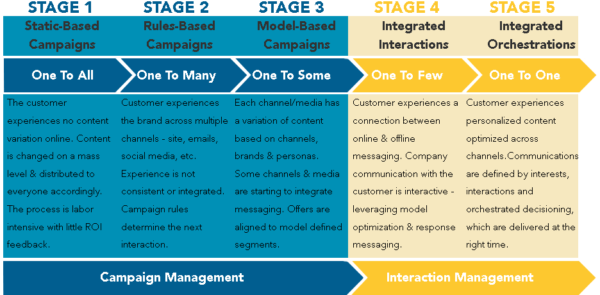
Using Personalized Content Marketing To Compete and Win
Today’s CMOs spend over 25 percent of their budget on content marketing. However, despite the fact that marketing leaders are heavily invested in delivering content designed to establish them as thought leaders and wise guides in the eyes of their prospects and customers—not all are getting the same results. According to Erika Varagouli, the Global Content Strategist at Semrush, “In the crowded waters of content marketing, it is getting harder than ever to grab your audience’s attention utilizing generic material. By personalizing your content, you are more likely to engage your targeted customers.”
Defining Content Personalization
In its simplest definition, content personalization is about using data to provide your customers with the information they want at the moment that they want it. As an essential part of the successful marketer’s data-driven strategy, content personalization is the key to optimizing the ROI of your marketing campaigns. When you are able to equip customers with content that is personally relevant to them in real-time, it reiterates to them that you are paying attention to what they want and you are working hard to be intuitive to their needs by supplying it.
The Purpose of Content Personalization
Research maintains that the customer’s experience is now more important than both price and the actual product itself. Yes, you read that right. Our fragmented and socially isolated society is looking for connection anywhere it can find it and your ability to deliver an engaging experience to your customers via personalized content will determine just how connected (loyal) they feel to your company.
Like any relationship, your customers need to know that you personally care about them, and their needs and interests. They do not want to be another faceless number in your upward trajectory of sales. They want to feel known, listened to and cared for. While this may seem like a daunting task, especially if your customer database holds hundreds, thousands or even hundreds of thousands of contacts, it is a scalable endeavor, thanks to modern martech. Depending on your current content strategy and your marketing technology stack’s setup, you can automate the process of personalizing content.
The Five Stages of Content Personalization
According to a table developed by the Content Marketing Institute (see below), there are five stages of personalizing marketing content. Of course, the ultimate goal for marketers seeking to wield the powers of personalization to their greatest advantage is to reach Stage 5, which outlines the ideals of account-based marketing (ABM).

Personalizing the Points in Your Customer’s Journey
There are endless ways to use the data your martech is gathering to personalize content throughout each customer’s journey. You can use customer personas based on your ideal customer profile (ICP), which likely includes data variables such as demographics, geography, industry, company size, titles, etc. Once you know the characteristics of your ICPs you can create targeted content for them and send it according to how you have your lists segmented.
When creating a personalized journey for customers, it’s important to address their behavior patterns and acknowledge their preferences. For example, if a customer is browsing certain blogs on your site via a mobile device, sending content recommendations to them based on what they have already demonstrated an interest in via an SMS message is a smart way to personalize their content.
Opportunities to Engage in Content Personalization
When it comes to personalizing content, there are numerous ways to begin creating a more compelling journey for your customers by customizing both inbound and outbound marketing pieces. Naturally, your website is a great place to begin. From web images that transition to mirror your customers’ personas and aspirations, to landing pages that address the specific problems they are trying to solve, there are many ways to subtly personalize content so that customers feel represented and understood by your brand. Other places to consider personalizing content based on visitor data include specific sections of a page, headers, subheads, images, body copy, sidebars and calls to action (CTAs). In addition to your website, don’t miss opportunities to further personalize a customer’s experience via transactional communications, such as invoices, receipts, shipping notifications, account updates and more.
Enabling Sales and Empowering Customer Service Reps Via a Robust Content Library
The power that personalized content has to drive results multiplies when you develop and maintain a library of marketing-approved pieces and make it available for sales teams and customer service reps to use. A few of the pieces we recommend including in your content library are:
- Articles
- Birthday Greetings
- Blogs
- Brochures
- Campaigns (email, SMS, etc.)
- Case Studies
- Customer Anniversary Greetings
- Customer Spotlights
- Customer Testimonials
- E-books
- Events
- Guides
- Holiday Greetings
- Infographics
- News
- Pictures
- Podcasts
- Pricing Sheets
- Sell Sheets
- Promotional Opportunities
- Recommendations
- Reports
- Reviews
- Seasonal Communications
- Videos
- Webinars
- White Papers
The 5 Benefits of Personalized Content Marketing
In the event you need more inspiration, there are loads of exciting statistics that show you the value of personalizing content. Here are five big benefits to consider:
1. Personalized Content Marketing Empowers You to Deliver What Customers Want
90% of U.S. customers find personalized marketing content somewhat to very appealing
2. Personalized Content Marketing Enhances Customer Loyalty
99% of marketers say personalization helps advance customer relationships, and 78% claim it has a “strong” or “extremely strong” impact
3. Personalized Content Marketing Increases Customer Engagement
Message personalization is the #1 tactic used by email marketers to increase engagement rates
4. Personalized Content Marketing Leads to More Effective and Efficient Marketing Spend
Personalization reduces acquisition costs as much as 50%, lifts revenues by 5-15%, and increases the efficiency of marketing spend by 10-30%.
5. Personalized Content Marketing Increases Sales
80% of customers are more likely to make a purchase when brands offer personalized experiences
